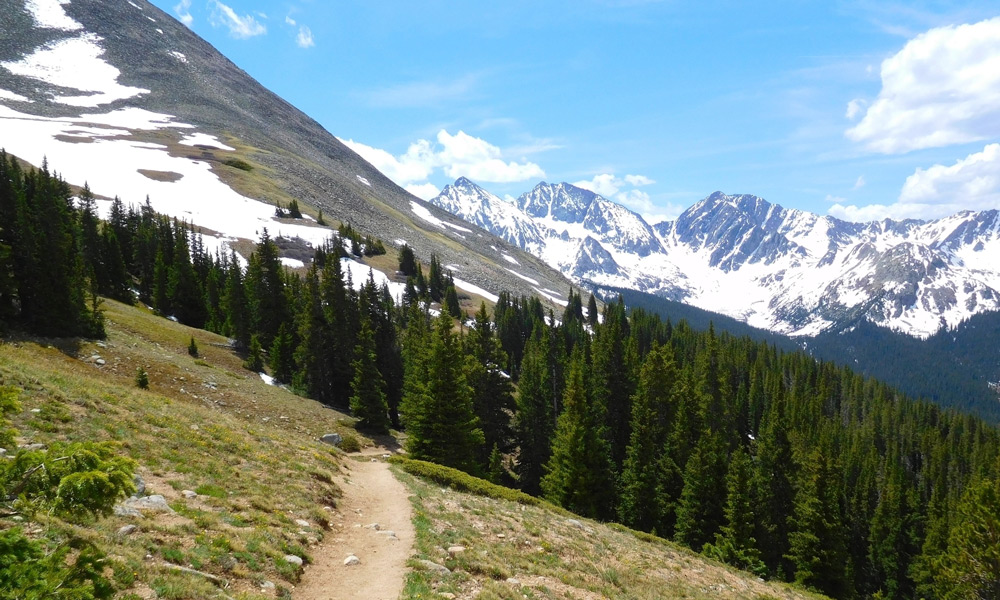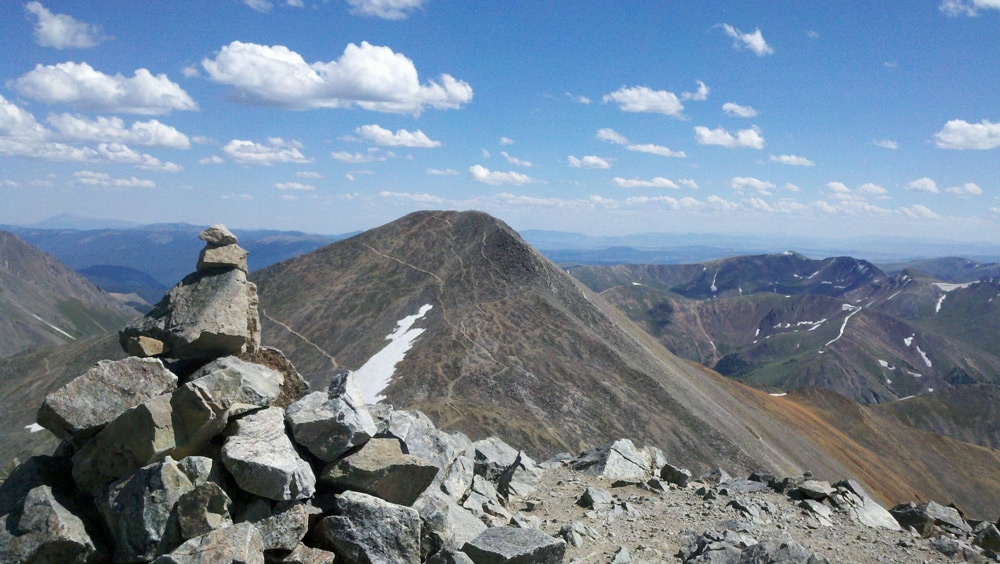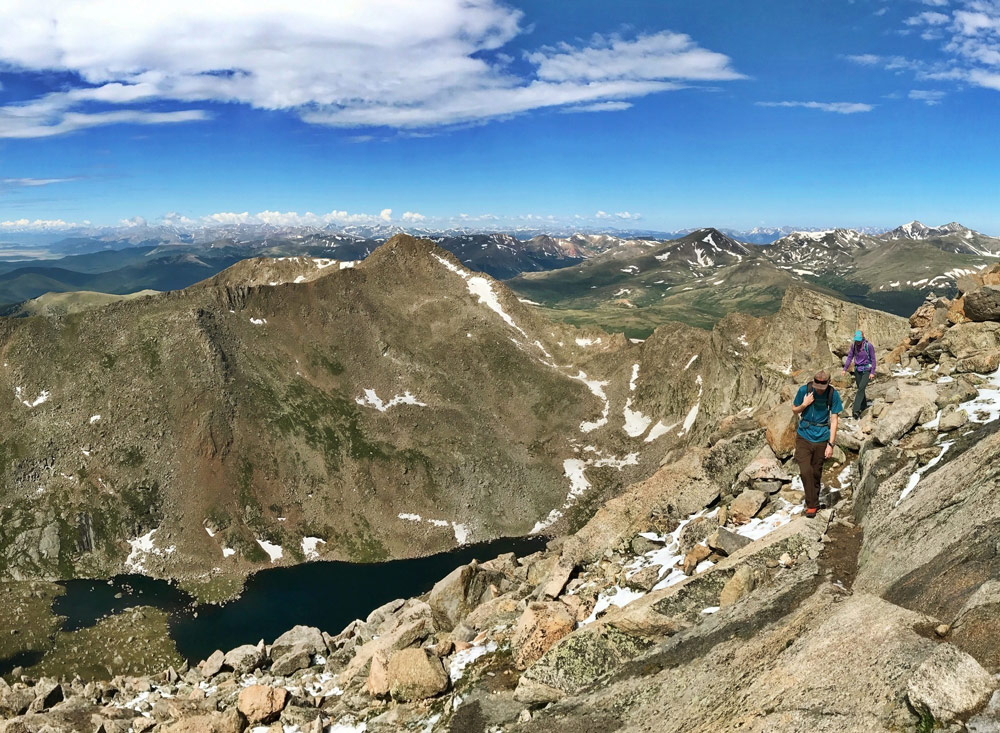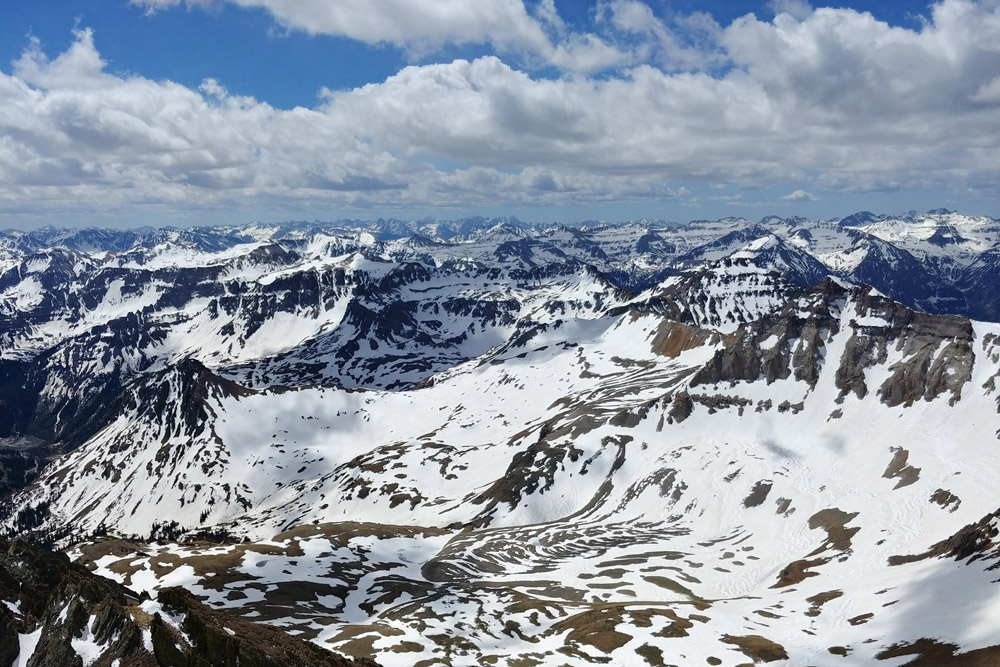Hiking 14,000-foot peaks, or 14ers, takes on a special significance in Colorado. Reaching the summit isn’t simply a weekend endeavor, it’s a rite of passage for locals and visitors alike. They’re also often physically and mentally demanding, so it’s important to make sure you’re prepared appropriately. Of Colorado’s 54 peaks and 140-plus routes, here are our favorites for their scenery, views, proximity to Denver and, of course, the unforgettable experience they offer.
Huron Peak
- Location: 27 miles northwest of Buena Vista
- Distance: 6.4-mile loop
- Difficulty: Intermediate
- Best For: 14er newbies
- Dogs: Leashed
Huron Peak delivers a challenge similar to the relatively mellow ascents of Mount Bierstadt and Grays and Torreys Peaks, minus the Front Range crowds. Nestled in the Collegiate Peaks Wilderness Area of the San Isabel National Forest, the mountain ekes out 14er status by just 3 feet. It’s also a non-technical summit, meaning it doesn’t require glacier travel, vertical climbing skills or specialized equipment, making it a popular choice for first-time 14er baggers. But be ready for a steady, calf-burning climb to the top. The route starts in the forest before opening up to a large field with views of the Three Apostles, three prominent 13,000-foot peaks that look like they belong in the Tetons rather than the Sawatch Range. The commanding summit vista makes it impossible to resist taking a selfie with the Apostles as your backdrop. Leadville and Buena Vista, both around an hour from the trailhead, make good post-hike pit stops if you’re craving a bite.

On the way to Mount Huron. (Photo credit: Hiking Project contributor Mike Langenkamp)
Mount Elbert
- Location: 16 miles south of Leadville
- Distance: 8.9-mile loop
- Difficulty: Intermediate/Difficult
- Best For: Bragging rights
- Dogs: Leashed
At 14,433 feet, Mount Elbert is the tallest 14er in Colorado and the highest peak in the entire Rocky Mountain Range. But don’t be intimidated by its height. Despite the impressive stats, the peak is generally considered to be one of the easiest 14ers to summit, and the standard Northeast Ridge route is a non-technical ascent, typically doable with a basic level of fitness and proper planning. (The east ridge, or South Mountain Elbert route, is more difficult but also less crowded.) Trekking poles will come in handy for the small creek crossings, and you’ll want to be on the trail by 6am to help avoid afternoon storms. It’s a 2.5-hour drive from Denver, so plan to wake up early or camp next to the trailhead at Elbert Creek Campground. The first quarter of the hike is on forested trail, but once you reach 13,500 feet, you’ll be able to look south and see Box Lake and the sharp spine of the Northeast Ridge. Be prepared for not one, not two, but three false summits before you reach the “Roof of the Rockies” and the stellar views of Mount Massive, Mount Harvard, Twin Lakes and the Continental Divide.
Grays and Torreys Peaks
- Location: 10 miles southwest of Georgetown
- Distance: 8.3-mile loop
- Difficulty: Intermediate/Difficult
- Best For: Double dipping
- Dogs: Leashed
There’s no such thing as an easy 14er, much less two. But if you want to double dip, Grays and Torreys Peaks, located just off I-70 about 75 minutes from Denver, are definitely doable in one day. They’re also incredibly popular. Midweek trail traffic is the norm in summer, so you’ll want a predawn start, especially if you hope to nab parking near the trailhead. (Parking in the lower lot adds 6 miles round trip to your hike.) You’ll reach 14,270-foot Grays Peak, the highest point on the Continental Divide, first. Then it’s less than a mile to traverse the saddle to Torreys Peak which looks out over I-70 and Summit County ski resorts like Breckenridge and Arapahoe Basin. Then it’s back down the saddle for a beer and a burger in Dillon’s Dillon Dam Brewery before you head back to Denver.

Grays Peak as seen from Torreys Peak. (Photo credit: Hiking Project contributor Mike Langenkamp)
Mount Evans
- Location: 40 miles southeast of Georgetown
- Distance: 2.4 miles
- Difficulty: Intermediate/Difficult
- Best For: Sunrise views
- Dogs: Leashed
One of the six Front Range 14ers, Mt. Evans is less than two hours from Denver, which means you can tag the summit and be back in the city in time for a late brunch. Plus, it’s worth an early start just to catch the pastel sunrise reflecting off Summit Lake. (Though you can cheat and drive most of the way to the top.) Mountain Evans Ridge Trail #51 is the most popular footpath to the peak and summits 13,842-foot Mt. Spalding along the way. Keep an eye out for the resident bighorn sheep and summer wildflowers. If you want to truly test your mettle, try cycling to the top. It’s a classic Colorado hill climb that gains 6,500 feet of elevation in 27.5 miles. (The secret to success: Pack layers for the chilly descent.) There’s often a crowd of tourists in the parking lot near the peak, so whether you hike or bike, you can always try to hitch a ride back down if you’re feeling wiped out.

Navigating a scree field on Mount Evans. (Photo credit: Hiking Project contributor Sarah Baker)
DeCaliBron
- Location: 38 miles south of Copper Mountain
- Distance: 7.0-mile loop
- Difficulty: Intermediate/Difficult
- Best For: Bang for your buck
- Dogs: Leashed
Conquering four 14ers in a single day sounds like a Herculean feat. But combining Mount Democrat, Cameron, Lincoln and Bross (better known as DeCaliBron) is achievable for many hikers. The route isn’t all that long or technical, but spending most of your day above 13,000 feet means you’re sure to feel the altitude. Stock up on water and snacks in nearby Breckenridge. You’ll need them. Mt. Democrat may be the shortest of the four peaks at 14,148 feet, but it’s the most strenuous to climb. At the top, you’ll be surrounded by a sea of peaks that, on a clear day, extend all the way to the Elk Mountains near Aspen. The hike to the summit of Mt. Cameron is easier, and from the peak you’ll traverse some lunar-like terrain to Mt. Lincoln, the highest point of the trek and the eighth-highest mountain in the state. From the top it’s possible to take in Pikes Peak to the south, Maroon Bells to the west, Mount of the Holy Cross to the north and Grays and Torreys Peaks to the east in a single 360-degree spin. The route then passes just below the privately owned peak of Mount Bross, so no one will blame you for counting it towards your total. Toast to your summit with brisket and bourbon at Breckenridge Distillery.
Mount Sneffels
- Location: 10 miles from Ouray
- Length: 5-mile loop
- Difficulty Rating: Difficult
- Best For: True wilderness
- Dogs: Leashed
Affectionately known as the Queen of the San Juans due to its prominence and its panoramic views of Telluride, Blue Lakes and Wilson Mountains, this 14,150-foot peak is also conveniently close to the historic mining town of Ouray. Still, you’ll need 4WD to reach the 11,300-foot lower trailhead in the Mount Sneffels Wilderness Area’s Yankee Boy Basin, one of Colorado’s best wildflower-viewing areas, particularly in midsummer. And it only gets harder from there. It’s a steep Class 3 hike, meaning it requires plenty of exposed scrambling. Bring a helmet, and in April, May and early June, you’ll most likely need crampons and ice axes. Your reward is a view that stretches all the way down into Utah’s Canyonlands on a clear day. Start early so you have plenty of time for a post-summit soak in Ouray’s recently renovated hot springs and beers on Ouray Brewery’s rooftop patio.

The view from Mount Sneffels. (Photo credit: Hiking Project contributor Michael Smith)
Longs Peak
- Location: 11 miles south of Estes Park
- Length: 14.2-mile out and back
- Difficulty Rating: Difficult
- Best For: Quintessential front ranger
- Dogs: No dogs
Only 90 minutes from Denver,14,259-foot Longs Peak is popular with the city’s weekend warriors, but don’t make the mistake of choosing it as your first 14er. This bucket list peak in Rocky Mountain National Park is a true challenge that deserves respect. You’ll want to build up your endurance at altitude, as the climb takes anywhere from 10 to 15 hours roundtrip and requires some serious scrambling and route finding. Just past the Boulder Field near the Chasm Lake overlook, you’ll find the Keyhole, a huge notch in Longs Peak’s North Ridge that marks the start of the Keyhole Route, a classic mountaineering trek that requires a helmet and involves scrambling up Class 3 terrain. Many consider the Homestretch, the final 0.2 miles of steep, exposed granite, to be the toughest bit. Others say the hike back down is just as daunting. But everyone agrees the views of Glacier Gorge, Black Lake and Powell Peak are well worth the physical and mental exertion. If you want to split the trek into two days, Boulder Field has eight, reservations-only campsites around 2 miles from the summit, but you’ll need to book at least 30 days in advance.
